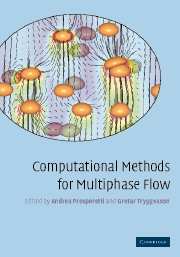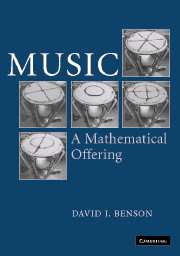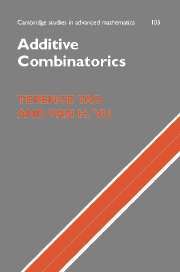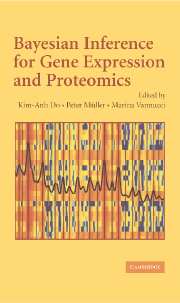Edited by Andrea Prosperetti / The Johns Hopkins University
Gretar Tryggvason / Worcester Polytechnic Institute,
Massachusetts
Computational Methods for Multiphase Flow
 Hardback (ISBN-13: 9780521847643 | ISBN-10: 0521847648)
Hardback (ISBN-13: 9780521847643 | ISBN-10: 0521847648)
Predicting the behavior of multiphase flows is a problem of
immense importance for both industrial and natural processes.
Thanks to high-speed computers and advanced algorithms, it is
starting to be possible to simulate such flows numerically.
Researchers and students alike need to have a one-stop account of
the area, and this book is that: it's a comprehensive and self-contained,
graduate-level introduction to the computational modeling of
multiphase flows. Each chapter is written by a recognized expert
in the field and contains extensive references to current
research. The book is organized so that the chapters are fairly
independent to enable it to be used for a range of advanced
courses. No other book offers the simultaneous coverage of so
many topics related to multiphase flow. It will be welcomed by
researchers and graduate students in engineering, physics, and
applied mathematics.
* Unique coverage for a single volume book
* Comprehensive and self-contained
* Features extensive references to current research
Contents
Preface; 1. Introduction: A computational approach to multiphase
flow A. Prosperetti and G. Tryggvason; 2. Direct numerical
simulations of finite Reynolds number flows G. Tryggvason and S.
Balachandar; 3. Immersed boundary methods for fluid Iinterfaces G.
Tryggvason, M. Sussman and M. Y. Hussaini; 4. Structured grid
methods for solid particles S. Balachandar; 5. Finite element
methods for particulate flows H. Hu; 6. Lattice Boltzmann methods
for multiphase flows S. Chen, X. He and L. S. Luo; 7. Boundary
integral methods for Stokes flows J. Blawzdziewic; 8. Averaged
equations for multiphase flows A. Prosperetti; 9. Point particle
methods for disperse flows K. Squires; 10. Segregated methods for
two-fluid models A. Prosperetti, S. Sundaresan, S. Pannala and D.
Z. Zhang; 11. Coupled methods for multi-fluid models A.
Prosperetti.
David J. Benson /University of Aberdeen
Music: A Mathematical Offering
 Hardback (ISBN-13: 9780521853873 | ISBN-10: 0521853877)
Hardback (ISBN-13: 9780521853873 | ISBN-10: 0521853877)
Paperback (ISBN-13: 9780521619998 | ISBN-10: 0521619998)
Since the time of the Ancient Greeks, much has been written about
the relation between mathematics and music: from harmony and
number theory, to musical patterns and group theory. Benson
provides a wealth of information here to enable the teacher, the
student, or the interested amateur to understand, at varying
levels of technicality, the real interplay between these two
ancient disciplines. The story is long as well as broad and
involves physics, biology, psycho acoustics, the history of
science, and digital technology as well as, of course,
mathematics and music. Starting with the structure of the human
ear and its relationship with Fourier analysis, the story
proceeds via the mathematics of musical instruments to the ideas
of consonance and dissonance, and then to scales and temperaments.
This is a must-have book if you want to know about the music of
the spheres or digital music and many things in between.
* The only modern account that is comprehensive and thorough
* Lots of musical examples that make the mathematical ideas
concrete; lots of illustrations
* Self-contained for the enthusiast but also usable as a course
text in mathematics, physics and engineering departments
Contents
Preface; Introduction; Acknowledgements; 1. Waves and harmonics;
2. Fourier theory; 3. A mathematician's guide to the orchestra; 4.
Consonance and dissonance; 5. Scales and temperaments: the
fivefold way; 6. More scales and temperaments; 7. Digital music;
8. Synthesis; 9. Symmetry in music; Appendix A. Bessel functions;
Appendix B. Equal tempered scales; Appendix C. Frequency and MIDI
chart; Appendix D. Intervals; Appendix E. Just, equal and
meantone scales compared; Appendix F. Music theory; Appendix G.
Recordings; Bibliography; Index.
Terence Tao / University of California, Los Angeles
Van H. Vu / Rutgers University, New Jersey
Additive Combinatorics
 Series: Cambridge Studies in Advanced Mathematics (No. 105)
Series: Cambridge Studies in Advanced Mathematics (No. 105)
Hardback (ISBN-13: 9780521853866 | ISBN-10: 0521853869)
Additive combinatorics is the theory of counting additive
structures in sets. This theory has seen exciting developments
and dramatic changes in direction in recent years thanks to its
connections with areas such as number theory, ergodic theory and
graph theory. This graduate level textbook will allow students
and researchers easy entry into this fascinating field. Here, for
the first time, the authors bring together in a self-contained
and systematic manner the many different tools and ideas that are
used in the modern theory, presenting them in an accessible,
coherent, and intuitively clear manner, and providing immediate
applications to problems in additive combinatorics. The power of
these tools is well demonstrated in the presentation of recent
advances such as Szemeri's theorem on arithmetic progressions,
the Kakeya conjecture and Erdos distance problems, and the
developing field of sum-product estimates. The text is
supplemented by a large number of exercises and new results.
* Comprehensive graduate level textbook for a highly active
current area of research
* The authors bring together for the first time the many
different tools and ideas that are used in the modern theory of
additive combinatorics
* The text is supplemented with a large number of exercises
Contents
Prologue; 1. The probabilistic method; 2. Sum set estimates; 3.
Additive geometry; 4. Fourier analytic methods; 5. Inverse sumset
theorems; 6. Graph theoretic methods; 7. The Littlewood-Offord
problem; 8. Incidence geometry; 9. Algebraic methods; 10.
Szemeri's theorem for k = 3; 11. Szemeri's theorem for k > 3;
12. Long arithmetic progressions in sumsets; Bibliography.
Edited by Kim-Anh Do / University of Texas, Houston
Peter Muller / University of Texas, Houston
Marina Vannucci / Texas A & M University
Bayesian Inference for Gene Expression and Proteomics
 Hardback (ISBN-13: 9780521860925 | ISBN-10: 052186092X)
Hardback (ISBN-13: 9780521860925 | ISBN-10: 052186092X)
The interdisciplinary nature of bioinformatics presents a
challenge in integrating concepts, methods, software, and multi-platform
data. Although there have been rapid developments in new
technology and an inundation of statistical methodology and
software for the analysis of microarray gene expression arrays,
there exist few rigorous statistical methods for addressing other
types of high-throughput data, such as proteomic profiles that
arise from mass spectrometry experiments. This book discusses the
development and application of Bayesian methods in the analysis
of high-throughput bioinformatics data, from medical research and
molecular and structural biology. The Bayesian approach has the
advantage that evidence can be easily and flexibly incorporated
into statistical models. A basic overview of the biological and
technical principles behind multi-platform high-throughput
experimentation is followed by expert reviews of Bayesian
methodology, tools, and software for single group inference,
group comparisons, classification and clustering, motif discovery
and regulatory networks, and Bayesian networks and gene
interactions.
* Novel Bayesian methods for the analysis of high throughput
bioinformatics data
* Applications to translational research
* Special case studies
Contents
1. An introduction to high-throughput bioinformatics data Keith
Baggerly, Kevin Coombes and Jeffrey S. Morris; 2. Hierarchical
mixture models for expression profiles Michael Newton, Ping Wang
and Christina Kendziorski; 3. Bayesian hierarchical models for
inference in microarray data Anne-Mette K. Hein, Alex Lewin and
Sylvia Richardson; 4. Bayesian process-based modeling of two-channel
microarray experiments estimating absolute mRNA concentrations
Mark A. van de Wiel, Marit Holden, Ingrid K. Glad, Heidi Lyng and
Arnoldo Frigessi; 5. Identification of biomarkers in
classification and clustering of high-throughput data Mahlet
Tadesse, Marina Vannucci, Naijun Sha and Sinae Kim; 6. Modeling
nonlinear gene interactions using Bayesian MARS Veerabhadran
Baladandayuthapani Chris C. Holmes, Bani K. Mallick and Raymond J.
Carroll; 7. Models for probability of under- and overexpression:
the POE scale Elizabeth Garrett-Mayer and Robert Scharpf; 8.
Sparse statistical modelling in gene expression genomics Joseph
Lucas, Carlos Carvalho, Quanli Wang, Andrea Bild, Joseph Nevins
and Mike West; 9. Bayesian analysis of cell-cycle gene expression
Chuan Zhou, Jon Wakefield and Linda L. Breeden; 10. Model-based
clustering for expression data via a Dirichlet process mixture
model David Dahl; 11. Interval mapping for Expression
Quantitative Trait Loci mapping Meng Chen and Christina
Kendziorski; 12. Bayesian mixture model for gene expression and
protein profiles Michele Guindani, Kim-Anh Do, Peter Muller and
Jeffrey S. Morris; 13. Shrinkage estimation for SAGE data using a
mixture Dirichlet prior Jeffrey S. Morris, Kevin Coombes and
Keith Baggerly; 14. Analysis of mass spectrometry data using
Bayesian wavelet-based functional mixed models Jeffrey S. Morris,
Philip J. Brown, Keith Baggerly and Kevin Coombes; 15.
Nonparametric models for proteomic peak identification and
quantification Merlise Clyde, Leanna House and Robert Wolpert; 16.
Bayesian modeling and inference for sequence motif discovery
Mayetri Gupta and Jun S. Liu; 17. Identifying of DNA regulatory
motifs and regulators by integrating gene expression and sequence
data Deuk Woo Kwon, Sinae Kim, David Dahl, Michael Swartz, Mahlet
Tadesse and Marina Vannucci; 18. A misclassification model for
inferring transcriptional regulatory networks Ning Sun and Hongyu
Zhao; 19. Estimating cellular signaling from transcription data
Andrew V. Kossenkov, Ghislain Bidaut and Michael Ochs; 20.
Computational methods for learning Bayesian networks from high-throughput
biological data Bradley Broom and Devika Subramanian; 21.
Modeling transcriptional regulation: Bayesian networks and
informative priors Alexander J. Hartemink; 22. Sample size choice
for microarray experiments Peter Muller, Christian Robert and
Judith Rousseau.
 Hardback (ISBN-13: 9780521847643 | ISBN-10: 0521847648)
Hardback (ISBN-13: 9780521847643 | ISBN-10: 0521847648) Hardback (ISBN-13: 9780521853873 | ISBN-10: 0521853877)
Hardback (ISBN-13: 9780521853873 | ISBN-10: 0521853877) Series: Cambridge Studies in Advanced Mathematics (No. 105)
Series: Cambridge Studies in Advanced Mathematics (No. 105) Hardback (ISBN-13: 9780521860925 | ISBN-10: 052186092X)
Hardback (ISBN-13: 9780521860925 | ISBN-10: 052186092X)